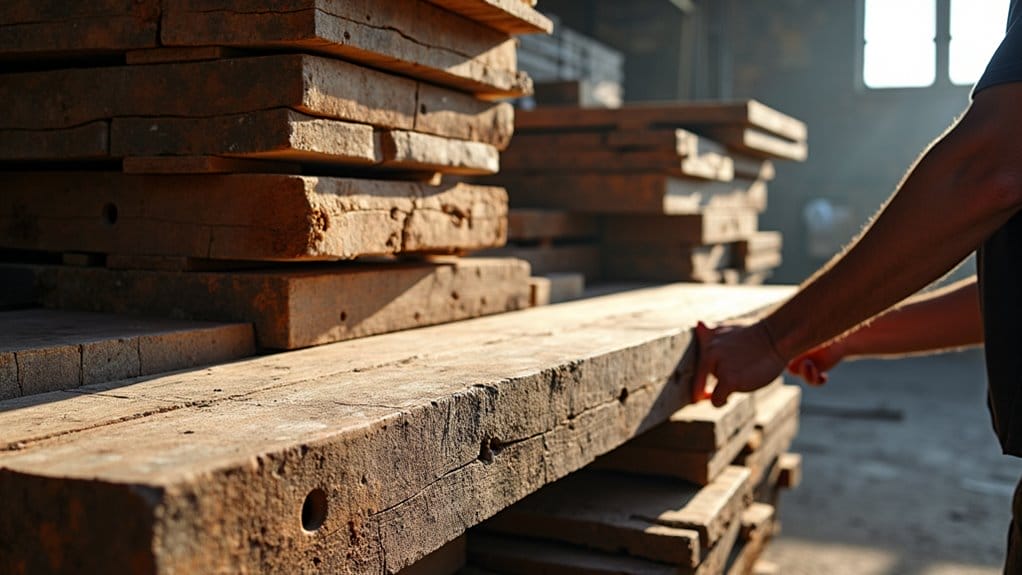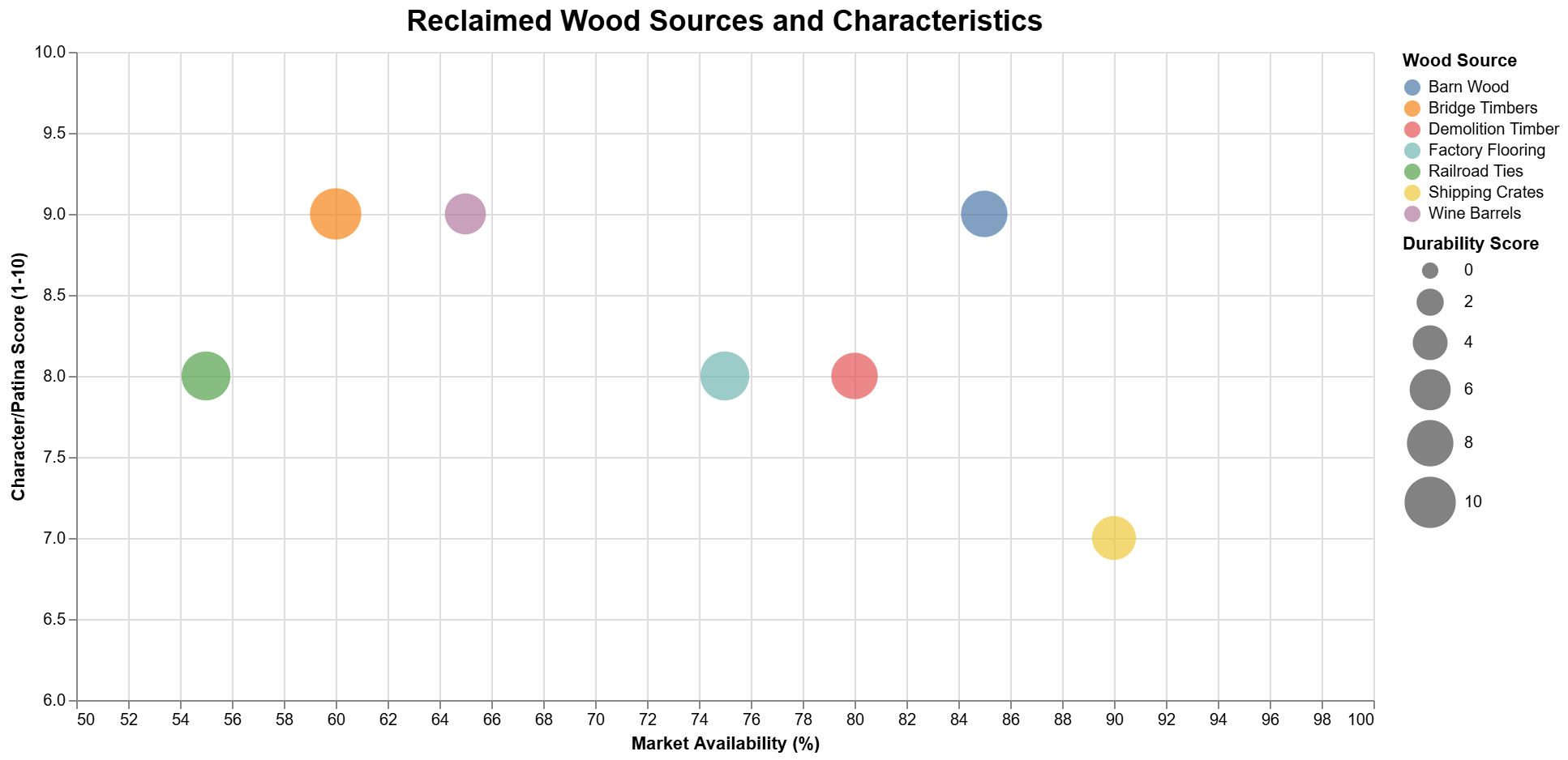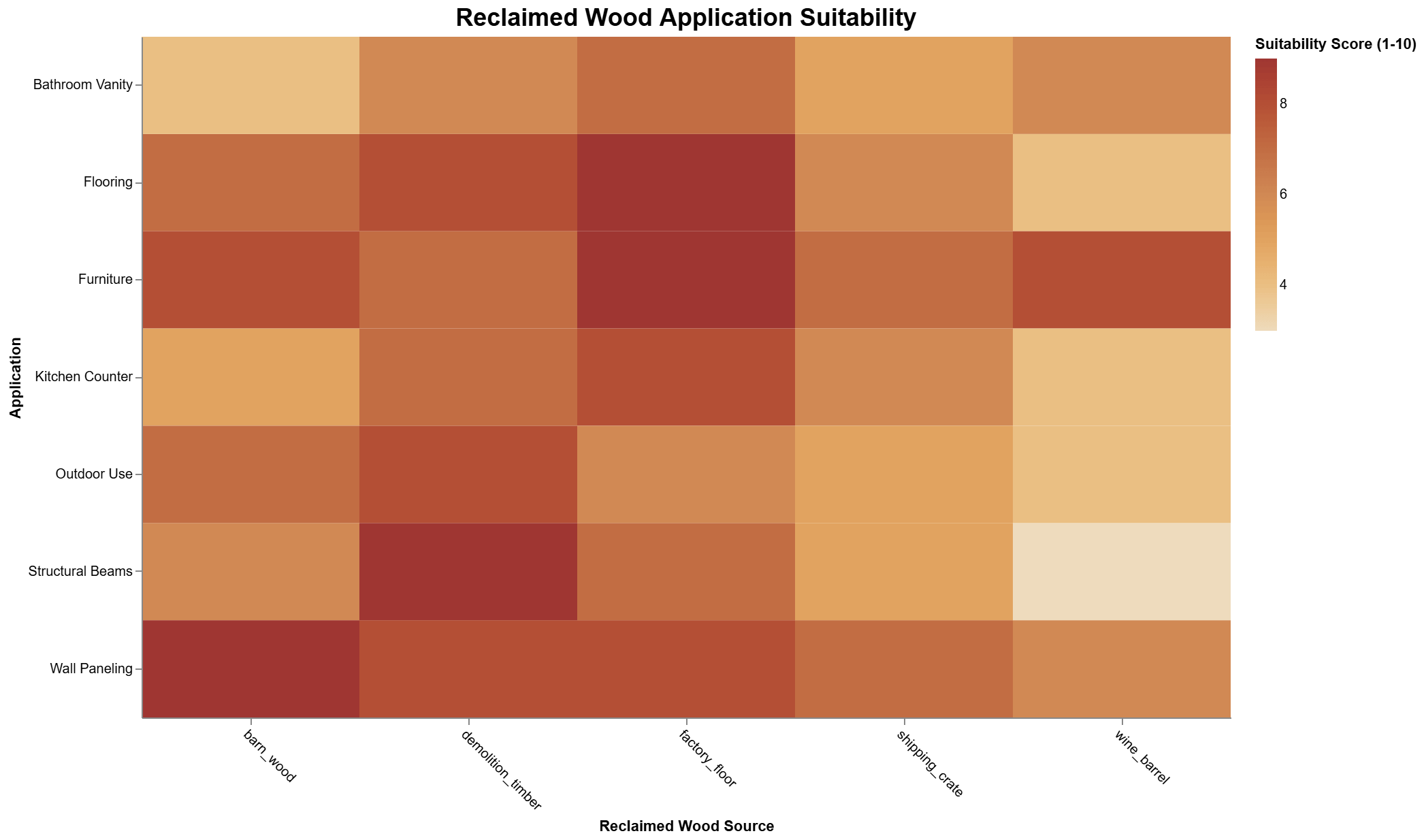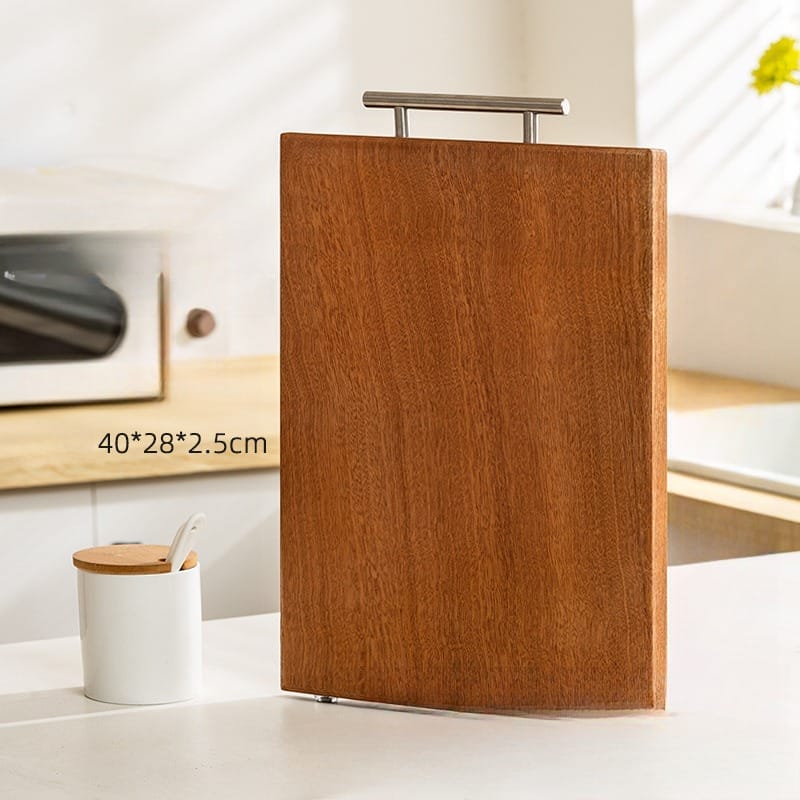You’ve likely noticed the distinctive look of weathered barn siding or the rich patina of century-old floor joists. That’s reclaimed wood – timber salvaged from old buildings and structures, given new life in modern applications. It’s more than just recycled material; it’s a sustainable choice that preserves forests, reduces landfill waste, and carries authentic historical value. Each piece tells a unique story, and you’ll want to know what makes this resource so remarkable.
Key Takeaways
- Reclaimed wood is salvaged timber from old structures like barns and warehouses, given new life through repurposing for modern construction.
- Using reclaimed wood prevents deforestation and reduces landfill waste while preserving natural resources for future generations.
- Each piece of reclaimed wood offers unique character through weathering, markings, and grain patterns that tell historical stories.
- Reclaimed timber contributes to LEED certification points and supports sustainable building practices in construction projects.
- The wood can be used in various applications, from flooring and furniture to statement walls and decorative mantels.
What is Reclaimed Wood?

Reclaimed wood refers to salvaged timber that’s been repurposed from its original application, such as old barns, factories, warehouses, and other structures.
You’ll find this versatile material sourced from dismantled railroad ties, wine barrels, shipping crates, and even sunken logs recovered from river bottoms.
Definition and Overview
The practice of salvaging and repurposing previously used wood materials has given rise to what we call reclaimed wood – a sustainable resource that’s breathing new life into modern construction and design.
When you source reclaimed wood, you’re utilizing timber that’s been extracted from old buildings, barns, factories, and other structures.
This salvaged wood gets a second chance while reducing the demand for new lumber. Instead of letting valuable materials end up in landfills, the recycle and reuse approach transforms aged timber into beautiful, character-rich elements for your projects.
Each piece carries its own history, making it both environmentally conscious and uniquely appealing.
Sources of Reclaimed Wood

Sourcing opportunities for reclaimed wood span across various industries and structures, each offering unique characteristics and historical significance.
You’ll find reclaimed lumber in old barns, featuring weathered oak and pine that’s developed rich patinas over decades of use.
Industrial warehouses and factories provide robust timber beams and flooring materials that have stood the test of time.
Salvage operations can help you locate wood from demolished buildings, bridges, and wine barrels.
Many architectural salvage yards specialize in preserving these materials, making it easier for you to access high-quality reclaimed wood for your projects.
Character and History of Reclaimed Wood

When you examine reclaimed wood up close, you’ll discover unique markings, nail holes, and natural weathering that tell stories of its past life.
Each piece of salvaged timber carries decades or even centuries of character, from old barns that weathered countless storms to factory beams that supported America’s industrial revolution.
You’re not just getting building material – you’re preserving a piece of history that connects your space to the craftsmanship and architecture of previous generations.
Unique Aesthetic Appeal
Naturally weathered through decades of exposure and use, reclaimed wood tells a unique story through its distinctive patterns, nail marks, and color variations.
You’ll find that each piece brings authentic character and history into your home design, creating an unmatched aesthetic appeal that new lumber simply can’t replicate.
The rustic charm of reclaimed wood perfectly aligns with biophilic design principles, connecting your interior design to nature.
From rich patinas to unique grain patterns, these timeless elements create focal points that draw attention and spark conversation.
Whether you’re designing a modern farmhouse or industrial loft, reclaimed wood adds warmth and personality to any space.
Stories Behind Reclaimed Timber
Each piece of reclaimed timber carries fascinating stories from its previous life, whether it once supported a century-old barn in Vermont or served as flooring in a historic Chicago warehouse.
When you choose reclaimed wood, you’re preserving pieces of early 20th century craftsmanship and architectural heritage.
That reclaimed barn wood might’ve witnessed decades of harvests, while industrial beams could tell tales of America’s manufacturing boom.
The process of reclaiming these materials isn’t just about reusing wood – it’s about connecting with history.
The Importance of Reclaiming Wood

When you choose reclaimed wood, you’re making a powerful environmental statement by preventing deforestation and reducing landfill waste.
You’ll discover significant economic advantages through potential cost savings on high-quality, already-seasoned lumber that often outperforms new materials.
Your decision to use reclaimed wood helps preserve both natural resources and craftsmanship heritage while supporting sustainable building practices.
Environmental Benefits

The environmental benefits of reclaimed wood extend far beyond simple recycling.
When you choose reclaimed timber, you’re actively preventing deforestation and supporting sustainable forestry practices. Each piece of repurposed wood reduces the demand for new lumber, decreasing the environmental impact of construction activities.
By incorporating reclaimed materials into green building projects, you’re helping minimize waste in landfills while preserving valuable natural resources. This eco-friendly approach also reduces carbon emissions associated with manufacturing new lumber.
The process is environmentally friendly from start to finish, making reclaimed wood one of the most sustainable building materials available.
Economic Advantages
Beyond its positive environmental impact, reclaimed wood offers compelling financial benefits for builders and homeowners alike.
While initial costs from reclaimed wood suppliers might be higher than new lumber from a mill, you’ll often save money in the long run.
Old-growth hardwood’s superior durability means fewer replacements and repairs over time.
During renovation projects, you’ll find that reclaimed wood’s unique character can increase your property’s value.
When you buy your reclaimed wood from reputable sources, you’re investing in sustainable practices that make economic sense, as the material’s strength and longevity offset the upfront expenses.
Sustainable Practices in Wood Use

When you choose reclaimed wood, you’re participating in sustainable practices that help preserve our planet’s forests and reduce landfill waste.
Understanding sustainability in reclaimed wood means recognizing its role in reducing the demand for virgin timber while giving new life to existing materials.
If you’re looking for verified sustainable sources, FSC-certified reclaimed wood guarantees your materials meet strict environmental and social responsibility standards.
Understanding Sustainability in Reclaimed Wood
Since sustainable practices drive modern woodworking, reclaimed wood stands out as a premier eco-friendly building material that preserves our forests while giving new life to existing timber.
When you choose reclaimed wood, you’re reducing the demand for new harvest and protecting essential forest ecosystems. Unlike newly processed lumber, reclaimed wood doesn’t require additional Forest Stewardship Council certification, as it’s already been sourced.
You’ll also find that aged timber contains fewer volatile organic compounds and has already completed its natural aging process, making it environmentally superior and more stable for sustainable building projects.
FSC-Certified Reclaimed Wood
Although reclaimed wood inherently supports sustainability, FSC certification adds an extra layer of environmental assurance. When you choose FSC-certified reclaimed wood, you’re getting materials that meet strict chain-of-custody standards, ensuring your recycled wood comes from verified sources.
| Feature | FSC-Certified | New Lumber |
|---|---|---|
| Environmental Impact | Minimal | High |
| Resource Depletion | None | Significant |
| Supply Chain Control | Strict | Variable |
The wood industry recognizes FSC certification as the gold standard for responsible sourcing. By selecting FSC-certified reclaimed wood, you’re supporting sustainable practices while getting the authenticity and character that only recycled timber can provide.
How to Use Reclaimed Wood

You’ll find that reclaimed wood flooring presents both rustic and refined options, from weathered barn boards to restored factory maple planks.
Your home’s design can seamlessly blend reclaimed wood through statement pieces like exposed beams, accent walls, or custom furniture.

Reclaimed Wood Flooring Options
When transforming reclaimed wood into flooring, you’ll discover several versatile installation methods that can enhance your home’s character.
Reclaimed wood flooring comes in various styles, from traditional hardwood flooring planks to engineered options. Before installation, verify the wood planks are properly kiln-dried to prevent warping and splitting.
You can choose between wide-plank formats, which showcase the wood’s natural character, or narrower strips for a more conventional look.
Each piece requires careful inspection and preparation, including removing old nails and addressing surface irregularities.
With proper care and maintenance, your reclaimed wood floors will continue telling their unique story for generations.
Incorporating Reclaimed Wood in Home Design
Since reclaimed wood adds character to any space, there are countless creative ways to incorporate it throughout your home.
You’ll find reclaimed wood products perfect for statement walls, exposed ceiling beams, and custom shelving. Use reclaimed timber for kitchen islands, countertops, or bathroom vanities to create rustic focal points.
Transform your living spaces with sliding barn doors, window frames, or decorative mantels.
As a homeowner, you can also integrate reclaimed materials into flooring and wall accents.
Consider furniture pieces like dining tables, headboards, or built-in benches to showcase the wood’s unique patina and history.
Choosing Reclaimed Wood

When selecting reclaimed wood for your project, you’ll need to evaluate key factors like the material’s age, structural integrity, and treatment history to guarantee it meets your specific requirements.
You can boost your project’s environmental impact by choosing LEED-certified reclaimed wood, which validates the material’s sustainable sourcing and handling processes.
LEED certification not only enhances your building’s green credentials but can also qualify your project for tax incentives and demonstrate your commitment to environmental stewardship.
Factors to Consider
Before investing in reclaimed wood, you’ll need to evaluate several essential factors that impact both the material’s quality and its suitability for your project.
When you choose reclaimed wood, consider its source, age, and structural integrity.
Examine each piece for signs of decay, insect damage, or contamination.
The type of wood and its previous use will influence its durability and appearance.
You’ll want to verify the supplier’s reputation and their way to source materials ethically.
Consider moisture content, as improper drying can affect stability.
Finally, ascertain the wood’s dimensions match your project requirements.
LEED Certification and Its Importance

Using reclaimed wood in your construction or renovation project can greatly contribute to LEED certification points, making it a valuable choice for sustainable building initiatives.
When products are made from reclaimed wood, they help reduce landfill waste and preserve natural resources. LEED certification considers factors like material reuse and environmental impact, which align perfectly with reclaimed wood’s benefits.
You’ll find that using reclaimed wood products supports human health and well-being through improved indoor air quality and reduced chemical exposure. Reclaimed wood can be used to earn points in multiple LEED categories, including Materials & Resources and Indoor Environmental Quality.
Care and Maintenance of Reclaimed Wood

You’ll find that maintaining reclaimed wood requires consistent attention to protect its unique character and structural integrity.
In kitchens and bathrooms, where moisture levels fluctuate, it’s crucial to apply appropriate sealants and monitor for any signs of water damage or warping.
Regular cleaning with eco-friendly products and prompt attention to spills will help preserve your reclaimed wood’s natural beauty while extending its lifespan in these challenging environments.
Wood Requires Special Care
While reclaimed wood brings character and sustainability to any project, maintaining its unique qualities requires consistent care and attention.
When wood is reclaimed from old structures, it often needs special treatment before installation, especially in a kitchen or bathroom where moisture levels fluctuate. You’ll need to guarantee proper sealing to prevent water damage and warping.
Choose low-VOC finishes and cleaners to maintain the wood’s integrity while protecting your health. Avoid using harsh chemicals that can react with old glue and nails.
Regular dusting and immediate spill cleanup will help your wood flooring last for generations.
Tips for Maintaining Reclaimed Wood in Kitchens and Bathrooms
Since kitchens and bathrooms expose reclaimed wood to moisture and temperature changes, proper maintenance becomes essential for longevity. When you use reclaimed wood in your home’s wet areas, seal all surfaces thoroughly with marine-grade polyurethane.
Wipe spills immediately and use gentle, natural cleaners to protect the wood’s patina. Install proper ventilation to prevent moisture buildup.
Reclaimed wood planks need periodic resealing, especially in high-splash zones. Since wood is a natural material, inspect regularly for signs of wear or water damage.
Reclaimed wood makes beautiful features, but maintaining consistent room temperature and humidity levels will help preserve its authentic character for years to come.
Frequently Asked Questions
Is Reclaimed Wood More Expensive Than New Lumber?
You’ll typically pay more for reclaimed wood, as it requires extra labor to salvage, clean, and process. However, you’re investing in superior quality timber with unique character and sustainability benefits.
How Long Does It Take to Source Reclaimed Wood?
You’ll typically spend 2-6 weeks sourcing reclaimed wood, depending on your project’s size and specifications. Local salvage yards offer quicker turnaround, while specialty pieces from historic buildings take longer to locate.
Can Reclaimed Wood Be Used in Bathrooms and Wet Areas?
You can use reclaimed wood in bathrooms if it’s properly sealed and treated against moisture. Choose naturally rot-resistant species like cedar or teak, and apply marine-grade finishes for superior water protection.
What Certifications Should I Look for When Buying Reclaimed Timber?
Look for FSC Recycled certification, LEED documentation, and verification from the National Wood Flooring Association. You’ll also want chain-of-custody certificates proving your timber’s authentic reclaimed source.
Are There Specific Tools Needed for Working With Reclaimed Wood?
You’ll need a metal detector, pry bar, heavy-duty sander, moisture meter, and sturdy power tools. Don’t forget protective gear since reclaimed wood often contains hidden nails and industrial residues.
Conclusion
When you choose reclaimed wood, you’re making a conscious decision to protect our forests and reduce waste. You’ll find that each piece tells a unique story through its distinctive patina, nail marks, and weathered texture. By maintaining your reclaimed wood properly and selecting quality pieces, you’re not just creating beautiful spaces – you’re participating in sustainable practices that’ll benefit generations to come.






































